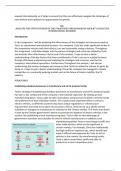expand internationally, as it helps to ensure that they can effectively navigate the challenges of
new markets and capitalise on opportunities for growth.
M5:
Analyse the effectiveness of the strategies and resources used by a selected
international business
Introduction:
In this assignment, I will be analysing the effectiveness of the strategies and resources used by
Tesla, as a prominent international business. As a company, Tesla has made significant strides in
the automotive industry with their electric cars and sustainable energy solutions. Throughout
this assignment, I will delve deeper into the various strategies and resources utilised by Tesla
and evaluate their effectiveness. By the end of this analysis, I hope to have a better
understanding of the key factors that have contributed to Tesla's success as a global business
through effectively undermining and analysing the strategies and resources used for the
company's international operations. Furthermore Throughout this analysis, I will also be
undermining the various strategies and resources that Tesla has utilised to achieve its goals. By
doing so, I hope to gain a better understanding of how the company has managed to remain
competitive in a constantly evolving market such as the future of kinetic mobility, the EV
industry.
Strategies
Establishing subsidiary businesses to manufacture and sell its products locally:
Tesla's strategy of establishing subsidiary businesses to manufacture and sell its products locally
has been a key component of the company's international expansion. By setting up local
manufacturing bases, Tesla is able to tailor its products and processes to better meet the needs
and preferences of each individual market. This is particularly important when it comes to
electric vehicles, as different countries may have unique regulations or infrastructure
requirements that need to be taken into account.In China, Tesla has set up a wholly-owned
subsidiary in Shanghai to manufacture its vehicles for the Chinese market. This move was driven
in part by the Chinese government's desire to promote the adoption of electric vehicles in the
country. By establishing a local manufacturing base, Tesla is able to take advantage of
government incentives and subsidies for electric vehicle manufacturers.In addition, local
manufacturing allows Tesla to avoid import tariffs and
other trade barriers, which can be significant in
certain markets. For example, China has traditionally
had high tariffs on imported cars, which would have
made it difficult and expensive for Tesla to sell its
vehicles in the country. By manufacturing locally,
Tesla is able to avoid these tariffs and offer its
products at a more competitive price.
, One of the key advantages of establishing subsidiary businesses is the ability to customise
products and processes to meet local needs. In China, Tesla has made a number of changes to
its vehicles to better suit the preferences of Chinese consumers. For example, the Chinese
version of the Model 3 features a unique air filtration system that is designed to protect
occupants from the country's high levels of air pollution. Tesla has also made changes to the
car's suspension and chassis to better handle China's often poorly-maintained roads. Another
advantage of local manufacturing is the ability to create jobs and stimulate local economies. In
China, Tesla's Shanghai factory is expected to create thousands of jobs and contribute to the
development of China's electric vehicle industry. This can help to build goodwill and support
from local governments and communities. However, there are also challenges associated with
establishing subsidiary businesses. One of the biggest challenges is the need to navigate local
regulations and legal frameworks. Different countries may have different labour laws,
environmental regulations, and other requirements that can be difficult to navigate. In addition,
establishing a local manufacturing base requires significant investment in infrastructure and
resources, which can be a barrier to entry for some companies.
Overall, the strategy of establishing subsidiary businesses has been an effective one for Tesla.
By manufacturing and selling locally, the company is able to customise its products and
processes to better meet the needs of each individual market, while also avoiding trade barriers
and creating local jobs. However, this strategy also requires significant investment and a
willingness to navigate complex regulatory environments. For Tesla, the benefits of this
approach have outweighed the costs, as evidenced by the company's successful expansion into
multiple international markets.
Entering into joint ventures with local companies to leverage their expertise and resources
Entering into joint ventures with local companies is a strategy that many companies use to
enter new markets. Joint ventures involve two or more companies coming together to form a
new entity, where they contribute resources and expertise to achieve a common goal. In Tesla's
case, partnering with local companies allows them to leverage their knowledge of the local
market, as well as their established networks and supply chains. One of the key advantages of
joint ventures is that they allow companies to quickly gain access to local expertise and
resources. For example, in China, Tesla's partnership with CATL allows Tesla to better
understand local market needs and preferences, allowing them to gain valuable insights into
local battery production and technology, which has enabled them to improve the performance
and reliability of their vehicles. Additionally, by partnering with local companies, Tesla is better
equipped to navigate the complex
regulatory and cultural landscape of the
Chinese market. However, joint ventures
can also be complex to manage and may
not always lead to a successful outcome.
For example, there may be differences in
culture, business practices, and strategic




